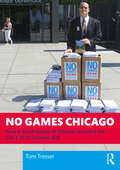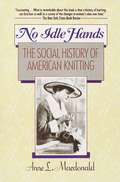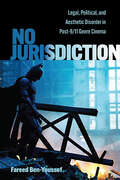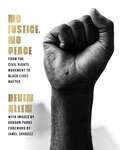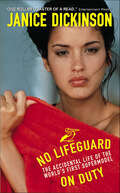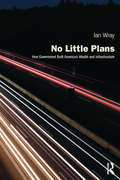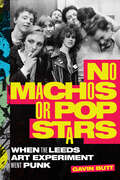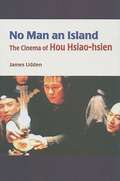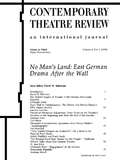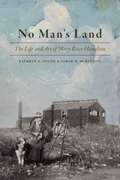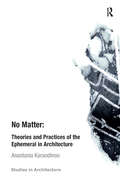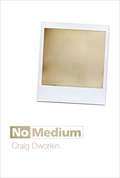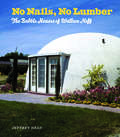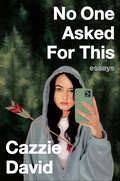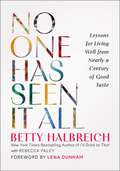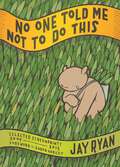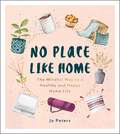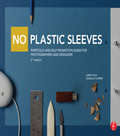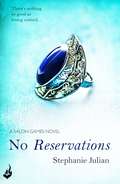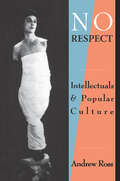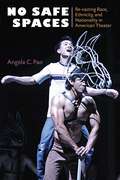- Table View
- List View
No Games Chicago: How A Small Group of Citizens Derailed the City’s 2016 Olympic Bid
by Tom TresserPromoted as a prestigious economic opportunity and often aggressively sought by local leaders, hosting a modern Olympics can in fact be a “city-killer” that racks up billions of dollars in over-budget expenses, degrades the environment, and shreds civil liberties. This book recounts the successful efforts of grassroots organization No Games Chicago to derail Chicago's bid for the 2016 Summer Olympics in an entertaining case study of local activism with international reach. The group’s detailed strategies and tactics provide a much-needed playbook for scholars, journalists, and activists seeking people-powered alternatives to megaprojects and other tourism-centric economic development schemes.In a time when vital public services are being cut and curtailed, public spaces diminished, and civil liberties threatened by the over-policing of protests, America continues to dedicate billions of public dollars to private development and sports facilities. The activists of No Games Chicago broke new ground in their fight to represent the voice of the people among established local political powers in the decision-making process for Chicago’s Olympic bid. Their story resonates both nationally and globally – over 15 cities around the world have said “No Thank You!” to the Olympics since the success of No Games Chicago.Relevant to students and chroniclers of deliberative democracy, public policy, media for social change, community organizing, and the economics of sport, No Games Chicago is an enjoyable, practical addition to the literature of citizen governance, urban planning, and economic development.
No Idle Hands: The Social History of American Knitting
by Anne MacdonaldExamines the history of the nation from the perspective of women and knitting, tracing the changes in day-to-day life and in women's roles in society from colonial times to the present.
No Jurisdiction: Legal, Political, and Aesthetic Disorder in Post-9/11 Genre Cinema (SUNY series, Horizons of Cinema)
by Fareed Ben-YoussefNo Jurisdiction interweaves autobiography and analysis to explore how a disabled American of French-Arab descent justifies his love for the (super)heroes who destroy brown people like himself. Framing Hollywood genre films as a key to understanding a crisis-filled world shaped by the global War on Terror, Fareed Ben-Youssef shows how, in response to 9/11, filmmakers and lawmakers mobilized iconic characters—the cowboy, the femme fatale, and the superhero—to make sense of our traumas and inspire new legal landscapes. The competing visions of power produced in this dialogue between Hollywood entertainment and mainstream politics underscore genre cinema's multivalent purpose: to normalize state violence and also to critique it.Chapters devoted to the Western, film noir, superhero movies, and global films that deploy and comment on these genres offer compelling readings of films ranging from the more apparent (The Dark Knight, Sicario, and Logan) to the more unexpected (Sin City, Adieu Gary, The Broken Circle Breakdown, and Tokyo Sonata). Through narratives of states of emergency that include vaguely defined enemies, obscured battlefield boundaries, and blurred lines between victims and perpetrators, a new post-9/11 film canon emerges. No Jurisdiction is a deeply personal work of film scholarship, arguing that we can face our complicity and discover opportunities for resistance through our beloved genre movies.
No Justice, No Peace: From the Civil Rights Movement to Black Lives Matter
by Devin AllenNautilus Book Awards' Better Books for a Better WorldA Movement in Words and Images Award-winning photographer Devin Allen has devoted the last six years to documenting the protests of the Black Lives Matter movement, from its early days in Baltimore, Maryland, up to the present day. The riveting images in No Justice, No Peace provide a lens on the resistance that has empowered Black lives generation after generation. Allen&’s signature black-and-white photos bear witness to the profound history of African Americans and allies in the fight for social justice and portray the collective action over decades in stunning, timeless portraits. Allen&’s remarkable photos of today&’s Black Lives Matter protests, which have been featured in the New York Times, the Washington Post, and twice on the cover of Time magazine, were inspired by Gordon Parks of the Civil Rights Movement, and create a vision of the past and future of Black activism and leadership in America. With contributions from twenty-six bestselling and influential writers and activists of today such as Clint Smith, DeRay Mckesson, D. Watkins, Jacqueline Woodson, Emmanuel Acho, Keeanga-Yamahtta Taylor, and more, alongside the words of past writers and activists such as Martin Luther King Jr, Frederick Douglass, Malcolm X, Maya Angelou, and John Lewis, No Justice, No Peace is a reminder of the moral responsibility of Americans to break unjust laws and take direct action. In words and pictures, No Justice, No Peace honors the connection between activism today and that of the past. If indeed hindsight is 20/20, this artistic look back is a lens on history that enlarges our understanding of the lasting predicament of racism in the United States of America. At once deeply intimate and profoundly uplifting, No Justice, No Peace is a visual tribute to Black resistance and a stern missive on the tough, but necessary, road that lies ahead.
No Lifeguard on Duty: The Accidental Life of the World's First Supermodel
by Janice Dickinson“Supermodel Dickinson's sex- and booze-soaked autobiography brings readers on a roller-coaster ride through the world of modeling” (Publishers Weekly).The life of Janice Dickinson is a story of extremes: uncontrolled energy, mad self-confidence and crushing insecurity, a boundless appetite for life and a ceaseless drive to self-destruct. During the 1970s she was the first lush-lipped, long-stemmed, dark-eyed brunette to break through and become not just a model but a supermodel—a term she coined for herself.She graced magazine covers from Vogue to Elle to Cosmopolitan, in photographs by Avedon and Irving Penn and fashions by Versace and Calvin Klein. She was voracious in everything: passionate affairs, endless partying, and a drug habit that dogged her through twenty years and three husbands. She spent her glory days with Gia Carangi and Christie Brinkley and her nights with Warren Beatty, Jack Nicholson, and Sylvester Stallone.Yet Dickinson’s life is no mere diva cartoon. Throughout her life she is haunted by the violent abuse she suffered at her father’s hands—a story she tells here for the first time. And as she careens from runway to rehab to rock bottom to recovery, readers will be captivated by her tale of survival.
No Little Plans: How Government Built America’s Wealth and Infrastructure (Planning, History and Environment Series)
by Ian WrayIs planning for America anathema to the pursuit of life, liberty and happiness? Is it true, as ideologues like Friedrich Von Hayek, Milton Friedman, and Ayn Rand have claimed, that planning leads to dictatorship, that the state is wholly destructive, and that prosperity is owed entirely to the workings of a free market? To answer these questions Ian Wray’s book goes in search of an America shaped by government, plans and bureaucrats, not by businesses, bankers and shareholders. He demonstrates that government plans did not damage American wealth. On the contrary, they built it, and in the most profound ways. In three parts, the book is an intellectual roller coaster. Part I takes the reader downhill, examining the rise and fall of rational planning, and looks at the converging bands of planning critics, led on the right by the Chicago School of Economics, on the left by the rise of conservation and the ‘counterculture’, and two brilliantly iconoclastic writers – Jane Jacobs and Rachel Carson. In Part II, eight case studies take us from the trans-continental railroads through the national parks, the Federal dams and hydropower schemes, the wartime arsenal of democracy, to the postwar interstate highways, planning for New York, the moon shot and the creation of the internet. These are stories of immense government achievement. Part III looks at what might lie ahead, reflecting on a huge irony: the ideology which underpins the economic and political rise of Asia (by which America now feels so threatened) echoes the pragmatic plans and actions which once secured America’s rise to globalism.
No Machos or Pop Stars: When the Leeds Art Experiment Went Punk
by Gavin ButtAfter punk’s arrival in 1976, many art students in the northern English city of Leeds traded their paintbrushes for guitars and synthesizers. In bands ranging from Gang of Four, Soft Cell, and Delta 5 to the Mekons, Scritti Politti, and Fad Gadget, these artists-turned-musicians challenged the limits of what was deemed possible in rock and pop music. Taking avant-garde ideas to the record-buying public, they created Situationist antirock and art punk, penned deconstructed pop ditties about Jacques Derrida, and took the aesthetics of collage and shock to dark, brooding electro-dance music. In No Machos or Pop Stars Gavin Butt tells the fascinating story of the post-punk scene in Leeds, showing how England’s state-funded education policy brought together art students from different social classes to create a fertile ground for musical experimentation. Drawing on extensive interviews with band members, their associates, and teachers, Butt details the groups who wanted to dismantle both art world and music industry hierarchies by making it possible to dance to their art. Their stories reveal the subversive influence of art school in a regional music scene of lasting international significance.
No Man an Island
by James UddenThis pioneering study of Hou Hsiao-hsien illuminates the many distinctive achievements of Taiwan's famous director. His body of work in films such as The Puppetmaster, City of Sadness, and Flowers of Shanghai reflects a powerfully unique style characterized by intricate lighting, improvisational acting, and exceptionally long, static shots. James Udden argues that Hou's films reflect Taiwan's peculiar historical and geographical situation and could only have emerged there. Udden also examines the regional impact Hou's films have had on other Asian directors and cinema artists.
No Man's Land
by David W. RobinsonThe political events of "annus mirabilis" 1989 marked a rare turning point in world history, but the significance of the year for German literary history is unique. As the 40-year-old German Democratic Republic ceased to exist, so too did the special circumstances which had fostered a literature separate from and in competition with that of the Federal Republic of Germany. A new period of literary history was delimited almost overnight: Germany Democratic Republic literature now was something to be examined as a whole, cultural movement. At the same time, the literary traditions of the German Democratic Republic have continued to influence the contemporary cultural scene, often in ways that are only gradually becoming clear.The essays, memoirs, and plays collected in this special issue of Contemporary Theatre Review represent an early attempt to assess and reassess one of the German Democratic Republic's richest cultural domains: its theatre. Contributors include David W. Robinson, C
No Man's Land: The Life and Art of Mary Riter Hamilton, 1868-1954
by Kathryn A. Young Sarah M. McKinnonWhat force of will and circumstance drove a woman from a comfortable life painting china tea services to one of hardship and loneliness in the battle zones of France and Belgium following the Great War? For western Canadian artist Mary Riter Hamilton (1868-1954), art was her life’s passion. Her tale is one of tragedy and adventure, from homestead beginnings, to genteel drawing rooms in Winnipeg, Victoria and Vancouver, to Berlin and Parisian art schools, to Vimy and Ypres, and finally to illness and poverty in old age. "No Man’s Land" is the first biographical study of Hamilton, whose work can be found in galleries and art museums throughout Canada. Young and McKinnon’s meticulous research in unpublished private collections brings to light new correspondence between Hamilton and her friends, revealing the importance of female networks to an artist’s well being. Her letters from abroad, in particular, bring a woman’s perspective into the immediate post-war period and give voice to trying conditions. Hamilton’s career is situated within the context of her peers Florence Carlyle, Emily Carr, and Sophie Pemberton with whom she shared a Canadian and European experience.
No Matter: Theories and Practices of the Ephemeral in Architecture (Ashgate Studies in Architecture)
by Anastasia KarandinouHow do digital media (mobile phones, GPS, iPods, portable computers, internet, virtual realities, etc.) affect the way we perceive, inhabit and design space? Why do architects traditionally design, draw and map the visual, as opposed to other types of sensations of space (the sound, the smell, the texture, etc.)? Architecture is not only about the solid, material elements of space; it is also about the invisible, immaterial, intangible elements of space. This book examines the design, representation and reception of the ephemeral in architecture. It discusses how architects map and examine the spatial qualities that these elements create and questions whether - and if so, how - they take them into account in the designing process. Karandinou argues that current interest in the ephemeral in contemporary culture and architecture is related to the evolution of digital media; and that it is related to the new ways of thinking about space and everyday situations that new media enables. With sound and video recording devices now being embedded in everyday gadgets and mobile phones, capturing sounds or ephemeral situations and events has become an everyday habit. New animation techniques allow designers to think about space through time, as they are able to design dynamic and responsive spaces, as well as static spaces explored by someone over time. Contemporary video games are no longer based on a simple visual input and a keyboard; they now involve other senses, movement, and the response of the whole body in space. This book therefore argues that the traditional binary opposition between the sensuous and the digital is currently being reversed. Subsequently, new media can also function as a new tool-to-think-with about space. Designers are now able to think through time, and design spaces accordingly. Time, temporality, ephemerality, become central issues in the designing process. The notion first claimed by Marshall McLuhan in the 1960s, that the emergence of new di
No Medium
by Craig DworkinIn No Medium, Craig Dworkin looks at works that are blank, erased,clear, or silent, writing critically and substantively about works for which there would seem to benot only nothing to see but nothing to say. Examined closely, these ostensibly contentless works ofart, literature, and music point to a new understanding of media and the limits of the artisticobject. Dworkin considers works predicated on blank sheets of paper, from a fictional collection ofpoems in Jean Cocteau's Orphée to the actual publication of a ream of typingpaper as a book of poetry; he compares Robert Rauschenberg's Erased De KooningDrawing to the artist Nick Thurston's erased copy of Maurice Blanchot's The Spaceof Literature (in which only Thurston's marginalia were visible); and he scrutinizes thesexual politics of photographic representation and the implications of obscured or obliteratedsubjects of photographs. Reexamining the famous case of John Cage's 4'33",Dworkin links Cage's composition to Rauschenberg's White Paintings, KenFriedman's Zen for Record (and Nam June Paik's Zen for Film),and other works, offering also a "guide to further listening" that surveys more than 100scores and recordings of "silent" music. Dworkin argues that we should understand medianot as blank, base things but as social events, and that there is no medium, understood inisolation, but only and always a plurality of media: interpretive activities taking place insocially inscribed space.
No Medium
by Craig DworkinClose readings of ostensibly “blank” works—from unprinted pages to silent music—that point to a new understanding of media.In No Medium, Craig Dworkin looks at works that are blank, erased, clear, or silent, writing critically and substantively about works for which there would seem to be not only nothing to see but nothing to say. Examined closely, these ostensibly contentless works of art, literature, and music point to a new understanding of media and the limits of the artistic object.Dworkin considers works predicated on blank sheets of paper, from a fictional collection of poems in Jean Cocteau's Orphée to the actual publication of a ream of typing paper as a book of poetry; he compares Robert Rauschenberg's Erased De Kooning Drawing to the artist Nick Thurston's erased copy of Maurice Blanchot's The Space of Literature (in which only Thurston's marginalia were visible); and he scrutinizes the sexual politics of photographic representation and the implications of obscured or obliterated subjects of photographs. Reexamining the famous case of John Cage's 4'33”, Dworkin links Cage's composition to Rauschenberg's White Paintings, Ken Friedman's Zen for Record (and Nam June Paik's Zen for Film), and other works, offering also a “guide to further listening” that surveys more than 100 scores and recordings of “silent” music.Dworkin argues that we should understand media not as blank, base things but as social events, and that there is no medium, understood in isolation, but only and always a plurality of media: interpretive activities taking place in socially inscribed space.
No More Nice Girls: Countercultural Essays
by Ellen WillisWith characteristic intelligence, wit, and feminist insight, Ellen Willis addresses democracy as she sees it: &“a commitment to individual freedom and egalitarian self-government in every area of social, economic, and cultural life.&” Moving between scholarly and down-to-earth activist writing styles, Willis confronts the conservative backlash that has slowly eroded democratic ideals and advances of the 1960s as well as the internal debates that have frequently splintered the left.
No Nails, No Lumber: The Bubble Houses of Wallace Neff
by Jeffrey HeadImagine a house constructed in less than forty-eight hours, without using lumber or nails, that is more resistant to fire, earthquakes, and hurricanes than any traditionally built structure. This may sound like the latest development in prefab housing or green architecture, but the design dates back to 1941 when architect Wallace Neff (1895–1982) developed Airform construction as a solution to the global housing crisis. Best known for his elegant Spanish Colonial–revival estates in Southern California, Neff had a private passion for his dome-shaped "bubble houses" made of reinforced concrete cast in position over an inflatable balloon. No Nails, No Lumber shows the beauty and versatility of Neff's design in new and vintage photography, previously unpublished illustrations, and archival material and ephemera.
No One Asked For This: Essays
by Cazzie DavidA NEW YORK TIMES BESTSELLER. From writer/director Cazzie David comes a series of acerbic, darkly funny essays about anxiety, social media, misanthropy, and growing up in a wildly eccentric family.For Cazzie David, the world is one big trap door leading to death and despair and social phobia. From shame spirals caused by hookups to panic attacks about being alive and everyone else having to be alive too, David chronicles her life’s most chaotic moments with wit, bleak humor, and a mega-dose of self-awareness. In No One Asked for This, David provides readers with a singular but ultimately relatable tour through her mind, as she explores existential anxiety, family dynamics, and the utterly modern dilemma of having your breakup displayed on the Internet. With pitch-black humor resonant of her father, comedy legend Larry David, and topics that speak uniquely to generational malaise, No One Asked for This is the perfect companion for when you don’t really want a companion."Blisteringly honest...kind of like if a David Sedaris book was written by an anxiety-ridden millennial who grew up in Hollywood."—Entertainment Weekly "Cazzie David is the delicious antidote to the poison of basic influencer culture. This book will make all misanthropes feel seen and loved—well, seen and tolerated."—Diablo Cody, screenwriter and author of Candy Girl
No One Has Seen It All: Lessons for Living Well from Nearly a Century of Good Taste
by Betty HalbreichFrom the New York City legend, bestselling author, and iconic stylist Betty Halbreich comes this wise and witty collection of guidance from her 96 years to help people of all ages look, feel, and live their best. For half a century, Betty Halbreich curated wardrobes and bore witness to the vicissitudes of life as Bergdorf Goodman&’s original personal shopper. Of course, visitors to the store were awed by a 96-year-old woman who still held down a nine-to-five, let alone one in the youth-obsessed industry of fashion. But age is only half the story: Betty built that career by giving encouraging yet deeply honest advice. Much of it was about what to wear, but her insight was by no means relegated only to matters of the closet. She was known for her good taste on many levels, from her immaculate Park Avenue apartment of 70-plus years to the fashion stars she helped discover and the looks she styled for iconic series like Sex and the City and Gossip Girl. In short, Betty was in the unique position to dispense useful prescriptions on how to look good and live well at any age. This collection of her writings from the last five years of her life contains her signature firm and frank guidance on relationships, careers, style, etiquette, and keeping house, as well as eloquent reflections on aging, solitude, and modern life. The result is a definitive dispatch from a powerful woman who always held her head up high, inspiring you to do the same.
No One Told Me Not to Do This: Selected Screenprints, 2009-2015
by Jay RyanOne of Indie Rock's Best Poster Artists (Pitchfork)"Ryan has been making strange little creatures since the mid-’90s, most often for bands in the Chicago area looking to promote concerts with something splashier than a Xeroxed flyer. His work is unmistakable: Whether it’s a bunch of animals cozied up under the covers or a smashed-up satellite advertising a Hum reunion, there’s nothing else exactly like it (and nothing nearly as charming)."--The A.V. Club, staff pick"Whether his subjects are whales, bears, mastodons, astronauts, dinosaurs, or his dilapidated garage, they’re rendered in warm colors, bold lines, and an instantly recognizable, beguiling and cartoonish style. If you lack sufficient wall space for another dozen of Ryan’s posters, get this."--The Big Takeover"The third collection of Ryan’s screen-printed work, covering 2009-2015, includes more than 50 band posters (Andrew Bird, Sonic Youth, St. Vincent) plus several festival posters."-- Publishers Weekly"A new select collection of recent poster and commercial work of artist Jay Ryan - someone whose crazy skills really do put the GREAT in 'greatest hits.’ It's rock poster art, alt-movie poster art and more."--Atomic Books Comic Preview, Largehearted Boy"[The book] features Ryan’s colorful and distinctive artwork, most of which are concert posters, including those for shows by queer artists including Bob Mould and St. Vincent."-- Living Out LI"An exceptional guide to not just Jay Ryan's art, but to the process involved in making superior screenprints."--Donovan's Literary Services, a Prime PickThis third collection of Ryan's "greatest hits" features prints made between 2009 and 2015, including posters for bands such as Andrew Bird, Shellac, My Morning Jacket, Sonic Youth, Dinosaur Jr., Hum, St. Vincent, and others, as well as posters featuring Lil BUB, Cards Against Humanity, various bicycle races, film screenings, and pictures of sloths, walruses, and other mammals in states of troubled sleep. With a foreword by master illustrator Aaron Horkey, this volume comprises two hundred screenprints with commentary and original drawings used in the screenprinting process.
No Place Like Home: The Mindful Way to a Healthy and Happy Home Life
by Jo PetersIt’s time to make your home a wellness zone! Your home environment should lift you up and bring you joy. No Place Like Home offers simple ways to transform your home environment to be more mindfully aligned with who you are. It’s packed with ideas for decluttering, comforting recipes to try and innovative ways to bring the outside in.
No Place Like Home: The Mindful Way to a Healthy and Happy Home Life
by Jo PetersIt’s time to make your home a wellness zone! Your home environment should lift you up and bring you joy. No Place Like Home offers simple ways to transform your home environment to be more mindfully aligned with who you are. It’s packed with ideas for decluttering, comforting recipes to try and innovative ways to bring the outside in.
No Plastic Sleeves: Portfolio And Self-promotion Guide For Photographers And Designers
by Larry Volk Danielle CurrierA polished and professional portfolio—including both print pieces and an online presence—is more important than ever for photographers and other creative professionals to make a great first impression and secure employment. This new edition of No Plastic Sleeves has been updated to address all facets of portfolio production, with a special focus on self-promotion and new information about blogs and social media’s role in the process. Including hundreds of photos, examples of successful design, and interviews with industry professionals, this text will guide you through the complete process of conceptualizing, designing, and developing all the interconnected aspects of your total portfolio package: Objectively evaluate and edit your work Develop a distinguishing brand concept Understand and apply effective design strategies Design a tailor-made portfolio book Develop a comprehensive online portfolio Develop printed professional and promotional materials Utilize social media and self-promotion strategies
No Plastic Sleeves: The Complete Portfolio and Self-Promotion Guide
by Larry Volk Danielle CurrierA polished and professional portfolio—including both print pieces and an online presence—is more important than ever for photographers, graphic designers, and other creative professionals to make a great first impression and secure employment. This new third edition of No Plastic Sleeves has been thoroughly updated across all facets of portfolio production, including increased coverage on self-promotion, social media, branding, online promotion, new and updated interviews, case studies, and more. Including hundreds of photos, examples of successful design from both students and professionals, and interviews with industry professionals, this text will guide you through the complete process of conceptualizing, designing, developing, branding, and promoting all the interconnected aspects of your total portfolio package, including teaching you how to: Objectively evaluate and edit your work Develop a distinguishing brand concept and identity Understand and apply effective design strategies, including layout and sequencing Design a tailor-made portfolio book Develop a comprehensive online portfolio Develop printed promotional and professional materials Utilize social media and self-promotion strategies Alongside the acclaimed companion website, www.noplasticsleeves.com— featuring additional portfolios, resources, tutorials, and articles—Larry Volk and Danielle Currier offer an essential guide to portfolio design, development, and promotion.
No Reservations: Salon Games Book 2 (Salon Games)
by Stephanie JulianFor fans of Maya Banks, Beth Kery and Jo Davis comes the second scorching-hot and intoxicatingly romantic installment in Stephanie Julian's Salon Games series.Play by the rules and you'll never get what you deserve.Tyler Golden is all about control. It's an attitude that helped him and his brother build Haven, a boutique hotel in Philadelphia. The only thing Tyler couldn't control was his fiancee's death. It left him emotionally guarded, and willing to go only so far with women: satisfying his sexual needs. Kate Song knows the feeling. Her sole focus is her dream to be a lingerie designer. She's not about to be distracted by any man. No matter who he is. Or how demanding. Or forceful. Or captivatingly sexy. Or so she thought. Tyler has the power to make her dream come true. Who can say no to such a dominating personality? Who would want to? Not Kate. Offering her body for submission is one thing. But giving her heart and soul is another. Now Tyler may discover that the one woman who taught him to love again is the one woman he might not be able to keep.This game isn't over yet... To play more seductive Salon Games, return to the series with Over Exposed. And don't miss Book One in the series, By Private Invitation.
No Respect: Intellectuals and Popular Culture
by Andrew RossThe intellectual and the popular: Irving Howe and John Waters, Susan Sontag and Ethel Rosenberg, Dwight MacDonald and Bill Cosby, Amiri Baraka and Mick Jagger, Andrea Dworkin and Grace Jones, Andy Warhol and Lenny Bruce. All feature in Andrew Ross's lively history and critique of modern American culture. Andrew Ross examines how and why the cultural authority of modern intellectuals is bound up with the changing face of popular taste in America. He argues that the making of "taste" is hardly an aesthetic activity, but rather an exercise in cultural power, policing and carefully redefining social relations between classes.
No Safe Spaces: Re-casting Race, Ethnicity, and Nationality in American Theater
by Angela C. Pao"No Safe Spaces opens up a conversation beyond narrow polemics . . . Although cross-racial casting has been the topic of heated discussion, little sustained scholarship addresses both the historical precedents and theoretical dimensions. Pao illustrates the tensions and contradictions inherent not only in stage representations, but also in the performance of race in everyday life. A wonderful book whose potential readership goes well beyond theater and performance scholars. " ---Josephine Lee, University of Minnesota "Non-traditional casting, increasingly practiced in American theater, is both deeply connected to our country's racial self-image(s) and woefully under-theorized. Pao takes on the practice in its entirety to disentangle the various strands of this vitally important issue. " ---Karen Shimakawa, New York University. No Safe Spaces looks at one of the most radical and enduring changes introduced during the Civil Rights era---multiracial and cross-racial casting practices in American theater. The move to cast Latino/a, African American, and Asian American actors in classic stage works by and about white Europeans and Americans is viewed as both social and political gesture and artistic innovation. Nontraditionally cast productions are shown to have participated in the national dialogue about race relations and ethnic identity and served as a source of renewed creativity for the staging of the canonical repertory. Multiracial casting is explored first through its history, then through its artistic, political, and pragmatic dimensions. Next, the book focuses on case studies from the dominant genres of contemporary American theater: classical tragedy and comedy, modern domestic drama, anti-realist drama, and the Broadway musical, using a broad array of archival source materials to enhance and illuminate its arguments. Angela C. Pao is Associate Professor of Comparative Literature at Indiana University. A volume in the series Theater: Theory/Text/Performance
